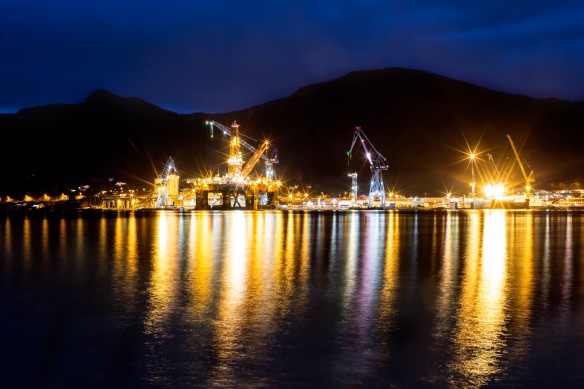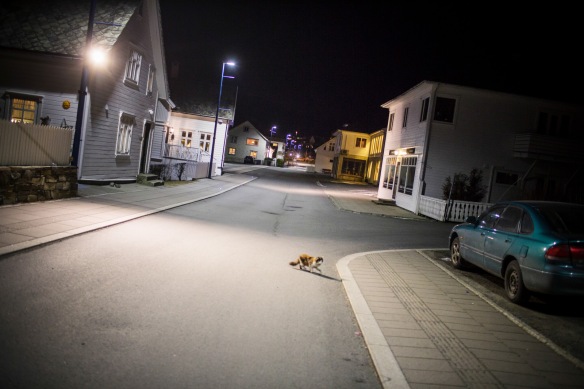Beyond the picture perfect beauty of Hardanger, the backside of the postcard is even more alluring.
The sound of Hardanger is very much the a cappella vocal approval of the visiting tourists, going “ooh” and “aah” and “sehr schön” and “ain’t that just lovely.” With hillsides clad in apple blossoms and snow-capped mountains diving into the blue-green waters of the fjord, Hardanger is the epitome of Norwegian romantic nationalism. I once took an English writer for a week long trip around these fjords in my old Ford Fiesta. That trip ended up as a nine page story in KLM’s inflight magazine – under the headline “Fjord Fiesta.” I’ve worked with other seasoned travel writers producing travel stories from this region as well, and more than once have heard them say: “I thought I was blasé, but this..!”
But this. This – as in the picture perfect postcard Hardanger – only exist between May and September. There are other sides to Hardanger as well. There is an end of the fjord. And Sørfjorden – the Southern Fjord – infamously known as the fjord that God forgot – ends in Odda.
Here, in this small industrial town built around a smelting plant now closed, two friends since childhood have spent most of the day in the kitchen. One of them – the hotel manager – is just off night watch and has chosen cooking over sleep. The other put on the roast even before going to bed from the party the night before (drunk slow roast – now that’s lovely). The table is set with white linens and the best dining wares. Several bottles of Amarone are breathing nicely, the fish soup starter has been simmering for hours and all is ready for one hell of a nice dinner. Oh, and I’m invited. Only that I don’t know. Not that it’s supposed to be a secret in any way, but my friend and colleague – the director of the fjordside mischief TV-series “Fjorden Cowboys” – just sort of forgot to mention it.
So there you have it. A short hour prior to the best meal I’ll have in quite a while, I’m sitting at a roadside tavern – under a confederate flag, no less – eating a roadside hamburger and spoiling my appetite. This shouldn’t come as a surprise to me. After all, the reason why I’m in Odda this March weekend, is to embrace the sudden and make a series of portraits based on chance meetings. I started the day talking to a guy feeding birds along the wharf. His name was Sigfred.
– So, Sigfred, how do you spend your days?
– From three minutes past two till five o’clock I listen to the radio. Other than that I feed the ducks.
Simple as that. Yet not simple at all. Sigfred told me he used to work at the zink plant, that’s the other giant smelting plant in the small town of Odda. And this goes for most of the people I meet this weekend. Most all of them are in some way connected to either the industry, the agriculture or both. Odda – the smelting plant town – and the fjords are in themselves a melting pot of both old farm culture and industrial identity, my friend Hildegunn Wærness tells me. And this blend of cultures has created some very tough and strong willed men and women – some of whom Hildegunn decided would make for great TV.
The result – the hit TV show “Fjorden Cowboys” – explores and celebrates Norwegian macho culture through the exploits of two entrepreneuring buddies who wear hats, love dynamite, talk trash and drink hard cider straight from the jerry can.
Last summer, I took a commision from the TV channel who was to air this show, to produce a set of promotional photos. This turned out to be one of the most fun jobs I did through all of 2013, but I was also left with a feeling that there were way more interesting people this end of the fjord than just the two main characters and their entourage.
For over half a year I had this urge to go back and make a portrait series from Odda and Sørfjorden, to explore the landscape beyond the picture perfect postcard. To meet with people that might have chosen to live a life slightly deviating from the norm of conformity – and make no mistake – I do mean that as a compliment.
So there we were – the director and me – on an adventure in the dark winter fjords – hoping to meet interesting people, to photograph them and maybe enjoy a drink in their company. And that we surely did. To such an extent that one of us incidentally failed to mention to the other that we had a dinner invitation.
For that I was mad for about five minutes. Then I remembered a quote from one of my favourite authors, Kurt Vonnegut: “Curious travel suggestions are dancing lessons from God.” Not that I’m religious, even less than the man with the guitar who earlier that day had sung to us: “I’m not religious – but I believe when I have to” – but as a reminder to embrace the sudden and unexpected, these words of Vonnegut are themselves good travel companions.
So off to dinner we went, me not quite as hungry as I would’ve liked to be, still expecting it to be brilliant. It was.
Strangely, drunkenly, Twin Peaks-ishly brilliant. Just as the end of the fjord itself.

























